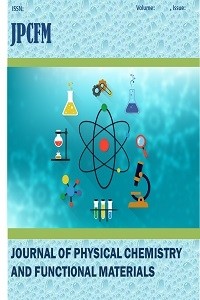Relationship between SSN, F107 and Z component of EMF during the 24th Solar Cycle
Relationship between SSN, F107 and Z component of EMF during the 24th Solar Cycle
SSN, F10.7 Earth’s Magnetic Field, Solar activity, 24th Solar Cycle,
___
- [1] J. J. Love, “Magnetic monitoring of earth and space,” Phys. Today, vol. 61, no. 2, pp. 31–37, Feb. 2008, doi: 10.1063/1.2883907.
- [2] O. Ozcan, S. Sağır and R. Atıcı “The Relationship between TEC and Earth's Magentic Field during Quiet and Disturbed days over Istanbul,Turkey” Advances in Space Research., vol. 65, no. 9, pp. 2167–2171, 2020, doi: 10.16/j.asr.2020.01.35
- [3] L. B. Liu, W. X. Wan, Y. D. Chen, and H. J. Le, “Solar activity effects of the ionosphere: A brief review,” Chinese Sci. Bull., vol. 56, no. 12, pp. 1202–1211, 2011, doi: 10.1007/s11434-010-4226-9.
- [4] M. Mandea and A. Chambodut, “Geomagnetic Field Processes and Their Implications for Space Weather,” Surv. Geophys., vol. 41, no. 6, pp. 1611–1627, 2020, doi: 10.1007/s10712-020-09598-1.
- [5] G. Hulot, T. J. Sabaka, N. Olsen, and A. Fournier, “The Present and Future Geomagnetic Field,” in Treatise on Geophysics, vol. 5, Elsevier, 2015, pp. 33–78.
- [6] C. C. Finlay, A. Jackson, N. Gillet, and N. Olsen, “Core surface magnetic field evolution 2000-2010,” Geophys. J. Int., vol. 189, no. 2, pp. 761–781, 2012, doi: 10.1111/j.1365-246X.2012.05395.x.
- [7] U. R. Christensen, J. Aubert, and G. Hulot, “Conditions for Earth-like geodynamo models,” Earth Planet. Sci. Lett., vol. 296, no. 3–4, pp. 487–496, 2010, doi: 10.1016/j.epsl.2010.06.009.
- [8] V. Lesur, S. Macmillan, and A. Thomson, “A magnetic field model with daily variations of the magnetospheric field and its induced counterpart in 2001,” Geophys. J. Int., vol. 160, no. 1, pp. 79–88, 2005, doi: 10.1111/j.1365-246X.2004.02479.x.
- [9] R. A. Langel, T. J. Sabaka, R. T. Baldwin, and J. A. Conrad, “The near-Earth magnetic field from magnetospheric and quiet-day ionospheric sources and how it is modeled,” Phys. Earth Planet. Inter., vol. 98, no. 3-4 SPEC. ISS., pp. 235–267, 1996, doi: 10.1016/s0031-9201(96)03190-1.
- [10] G. Hulot, C. C. Finlay, C. G. Constable, N. Olsen, and M. Mandea, “The magnetic field of planet earth,” Space Sci. Rev., vol. 152, no. 1–4, pp. 159–222, 2010, doi: 10.1007/s11214-010-9644-0.
- [11] A. Conway, K. Macpherson, and J. Brown, “Predicting the maximum of solar cycle 23,” Astron. Geophys., vol. 39, no. 2, pp. 222–224, 1998, doi: 10.1093/astrog/39.2.2.22.
- [12] M. O. F. Science, “Forecasting Solar Cycle 24 Using Neural Networks,” 2008.
- [13] P. Charbonneau, Dynamo models of the solar cycle, vol. 17, no. 1. Springer International Publishing, 2020.
- [14] David H. Hathaway, “The solar cycle,” Living Rev. Sol. Phys., vol. 12, no. 1, 2015, doi: 10.1007/lrsp-2015-4.
- [15] NOAA, “NOAA-NASA Space Weather.” https://www.swpc.noaa.gov/phenomena/f107-cm-radio-emissions (accessed Feb. 25, 2020).
- [16] “SILSO - 24th Solar Cycle Began.” http://sidc.be/silso/cyclesmm (accessed Feb. 15, 2021).
- [17] “SILSO - 24th Solar Cycle Ended.” http://sidc.be/silso/node/167/#NewSolarActivity (accessed Feb. 15, 2021).
- [18] “NASA- Omniweb.” https://omniweb.gsfc.nasa.gov/form/dx1.html (accessed Feb. 19, 2021).
- [19] A. Leguina, “A primer on partial least squares structural equation modeling (PLS-SEM),” Int. J. Res. Method Educ., vol. 38, no. 2, pp. 220–221, Apr. 2015, doi: 10.1080/1743727X.2015.1005806.
- [20] F. İ. Ergül DEMİR, Özkan SAATÇİOĞLU, “Uluslararası Dergilerde Yayımlanan Eğitim Araştırmalarının Normallik Varsayımları Açısından İncelenmesi,” Curr. Res. Educ., vol. 2, no. 3, pp. 130–148, 2016,
- [21] L. S. F. Barbara G. Tabachnick, Review of Using Multivariate Statistics., vol. 28, no. 8. 1983.
- [22] L. Vinet and A. Zhedanov, “A ‘missing’ family of classical orthogonal polynomials,” Routledge, pp. 1–814, Nov. 2010, doi: 10.1088/1751-8113/44/8/085201.
- [23] R. G. Dawson, B. & Trapp, “Basic & Clinical Biostatistics,” Basic Clin. Biostat., pp. 161–218, 2001.
- [24] S. Arndt, C. Turvey, and N. C. Andreasen, “Correlating and predicting psychiatric symptom ratings: Spearman’s v versus Kendall’s tau correlation,” J. Psychiatr. Res., vol. 33, no. 2, pp. 97–104, 1999, doi: 10.1016/S0022-3956(98)90046-2.
- [25] S. Kilic, “Interpretation of correlation analysis results,” J. Mood Disord., vol. 2, no. 4, p. 191, 2012, doi: 10.5455/jmood.20121209012824.
- [26] “Intermagnet.” http://www.intermagnet.org (accessed Feb. 09, 2021).
- ISSN: 2651-3080
- Yayın Aralığı: Yılda 2 Sayı
- Başlangıç: 2018
- Yayıncı: Niyazi BULUT
Characterization of SrO samples produced at two different temperatures
Turan INCE, Tankut ATEŞ, Niyazi BULUT, Serhat KESER, Omer KAYGİLİ
Utilization of Lignite and Waste Biomass As a Clean Energy Source by Carbonization
A theoretical study of charge-transfer properties of a new material involving naphthalenyl unit
Synthesis and characterization of Y-doped AlZn2O4 spinels
Hanifi KEBİROGLU, Ala HSSAIN, Bahroz KAREEM MAHMOOD, Omer KAYGİLİ
In vitro Biological Activities and Phytochemical Contents of Portulaca oleracea L. (Purslane)
Fatma KESER, Mustafa KARATEPE, Serhat KESER, Suat TEKİN, İsmail TÜRKOĞLU, Omer KAYGİLİ, Ersin DEMİR, Prof. Dr. Ökkeş YILMAZ, Süleyman SANDAL, Sevda KIRBAG
A Review on Photocatalyst self-cleaning glass
Rezhin Mahdi HABDURAHAMN, Zhiwar OMER, Bestoon HAMADAMEEN
Usman MUHAMMAD SANI, Sultan ERKAN
Relationship between SSN, F107 and Z component of EMF during the 24th Solar Cycle
